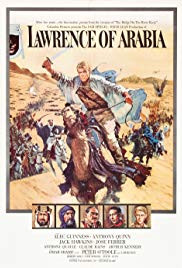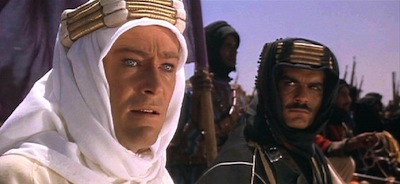LAWRENCE OF ARABIA
SUBJECTS — Biography; World/England, Middle East & WWI;
SOCIAL-EMOTIONAL LEARNING — Courage in War;
MORAL-ETHICAL EMPHASIS — Trustworthiness.
AGE; 12+; MPAA Rating — PG;
Drama; 1962; 221 minutes; Color.
There is NO AI content on this website. All content on TeachWithMovies.org has been written by human beings.

SUBJECTS — Biography; World/England, Middle East & WWI;
SOCIAL-EMOTIONAL LEARNING — Courage in War;
MORAL-ETHICAL EMPHASIS — Trustworthiness.
AGE; 12+; MPAA Rating — PG;
Drama; 1962; 221 minutes; Color.
TWM offers the following worksheets to keep students’ minds on the movie and direct them to the lessons that can be learned from the film.
Film Study Worksheet for Social Studies Classes for a Work of Historical Fiction and
Worksheet for Cinematic and Theatrical Elements and Their Effects.
Teachers can modify the movie worksheets to fit the needs of each class. See also TWM’s Historical Fiction in Film Cross-Curricular Homework Project.
This movie presents a fictionalized and romanticized account of the career of T.E. Lawrence (1888 – 1935). Lawrence was a legendary British Intelligence officer who, operating behind enemy lines during the First World War, incited an Arab revolt against the Turks.

Selected Awards:
1962 Academy Awards: Best Picture, Best Director (Lean), Best Art Direction/Set Decoration (Color), Best Color Cinematography, Best Film Editing, Best Sound, Best Original Score; 1962 British Academy Awards: Best Film, Best Actor (O’Toole), Best Screenplay; 1962 Directors Guild of America Awards: Best Director (Lean); 1963 Golden Globe Awards: Best Film-Drama, Best Director (Lean), Best Supporting Actor (Sharif); 1962 Academy Award Nominations: Best Actor (O’Toole), Best Adapted Screenplay, Best Supporting Actor (Sharif). “Lawrence of Arabia” is listed in the National Film Registry of the U.S. Library of Congress as a “culturally, historically or aesthetically significant” film. It is ranked #5 on the American Film Institute’s List of the 100 Greatest American Movies of All Time (2006).
Featured Actors:
Peter O’Toole, Omar Sharif, Anthony Quinn, Alec Guinness, Jack Hawkins, Claude Rains, Anthony Quayle, Arthur Kennedy, Jose Ferrer.
Director:
David Lean.
SERIOUS. This movie is not history. Members of Lawrence’s family have stated that the portrayal of Lawrence as a person is not accurate. There are also historical errors, for example, there is no evidence that T. E. Lawrence was present at the massacre of the Turks, one of the central scenes in the movie. Rather, “Lawrence of Arabia” is a fantasy about Lawrence set in an historical framework, i.e., the British campaign against the Turks in the Middle East during WWI; the role of Lawrence in fostering Arab independence, and the British and French betrayal of their promises to the Arabs that independence would be granted to them after WWI.
In addition, this is a war movie with violence and death. It is occasionally graphic. In the movie, the Lawrence character is forced by circumstances on two separate occasions to take out a gun and shoot a good friend to death. His actions are morally and militarily defensible in each instance, but they could be upsetting to sensitive children. They were deeply upsetting to Lawrence.
This movie portrays the Arabs of the early twentieth century as a people with barbaric ways who, in the words of the Prince Faisal character, are “unused to explosives and machines.” This is the standard Western view of Arabs of that time.
This movie is most helpful as an introduction to a little-known part of WWI. Read the Helpful Background section, take out a map and show your child where these battles were fought. Talk about the central tragedy of T.E. Lawrence’s life, that the British government went back on promises it had made to the Arabs and that Lawrence was the man who made those promises on behalf of the British.
Before the First World War, the empire of the Ottoman Turks governed most of Arabia.The Ottomans made the mistake of taking the side of Germany during the war. The British and French stimulated revolts against the Ottomans by promising the Arabs independence after the war. As a British operative, Lawrence helped carry out this policy. He and Prince Faisal mounted guerilla attacks against Turkish installations, including rail lines. Lawrence was present when the Arabs conquered the city of Damascus in 1918.
Unknown to Lawerence, the British and French governments never intended to grant independence to the Arabs. When hostilities ended, Lawrence tried to persuade the British government to fulfill their commitments to the Arabs. He even attended the peace conference at Versailles in an unsuccessful effort to get the Allies to grant Arab independence. All of Lawerence’s efforts were to no avail. After WWI, the Middle East was divided between the French and the British empires.
One of Lawrence’s brothers, Arnold Lawrence, a professor of archeology at Cambridge University in England, viewed this film’s portrayal of his brother as “pretentious and false.” According to Arnold Lawrence, T.E. Lawrence was nice and kind and “one of the most exhilarating people I’ve known.” Lawrence of Arabia, a Hero’s Journey, by Don Belt, National Geographic, Vol. 195, No. 1, January, 1989, pages 47.
T.E. Lawrence was a student and archaeologist before World War I. At college, Lawrence was an oddball ascetic; a serious minded student who did not participate in sports and who ate bread and water for lunch. He wrote his senior thesis on Crusader forts in the Middle East, gathering information by walking more than a thousand miles in what was then the Ottoman Empire. On this trip he became acquainted with the area, learned Arabic, and came to love the Arabian culture. After graduation he supervised Arab workers on several archaeological digs in the Middle East, further immersing himself in the local culture and forming strong friendships with some of the workers. When Britain needed Intelligence officers for the Middle East during the First World War, T.E. Lawrence was an ideal choice.
Many incidents in the film are taken from actual events. Lawrence was forced to personally execute a Bedouin who had killed another man. If he had not, the expedition he was on would have disintegrated into a round of revenge killings. After killing the man by shooting him three times, Lawrence was so upset that he had to be carried onto his camel. While on a reconnaissance patrol, Lawrence was captured, and then flogged and raped by the Turks. Lawrence was made famous by an American newspaper reporter, Lowell Thomas, who accompanied Lawrence and his Bedouin soldiers for eight days. After the war, Lawrence could have used his popularity to run for office but he refused all of the honors offered to him. He lobbied vigorously for the British to keep their promises to the Arabs for their independence.
Lawrence was a deeply private man who distrusted his own “passion for distinction.” For this reason and, perhaps, because of his disgust at his own role in the British betrayal of the Arabs, he retired from public life, joining the Royal Tank Corps and the Royal Air Force under assumed names. He served from 1923 to 1935, never accepting any promotion and avoiding the press, but keeping up a correspondence with many distinguished friends. He translated the The Odyssey for an American publishing company and wrote a critically acclaimed book about his experiences in the RAF, The Mint. Lawrence was killed in a motorcycle accident in 1935.
Lawrence’s book The Seven Pillars of Wisdom (1926) describes his wartime experiences and his personal philosophy. He was a neurotic and lonely man but a legendary figure due to his wartime exploits and his efforts on behalf of the Arabs.
The Arabian camel was first domesticated in Babylonia in about 1100 B.C.E. Camels can carry huge loads and withstand the loss of about 1/3rd of their body fluids. They do not carry water in their humps. Arabian camels can walk more than 100 miles in a day.
Many characters in the movie are historical. The character of Faisal is a combination of Emir Hussein and his son, Prince Faisal. It was Lawrence’s close relationship with Faisal that facilitated British/Arab cooperation during WWI. Edmund Allenby was a British General who led a brilliant campaign against the Turks in the First World War and captured Palestine and Syria.
Arabia is a peninsula in Southwest Asia bounded by the Red Sea, the Indian Ocean and the Persian Gulf. The people who populated the area in the early 20th century were primarily nomadic and not familiar with modern technology or methods of social organization. According to the movie, the concept of Arab unity was something advocated by Lawrence which had to be learned by most Arabs. As the Lawrence character states in the film: “So long as the Arabs fight tribe against tribe they will be a little people.”
1. See Discussion Questions for Use With any Film that is a Work of Fiction.
2. Locate Cairo, the Suez Canal, Mecca, Medina, Aqaba, the Arabian Peninsula, and the Sinai Peninsula on a map or a globe.
3. When Lawrence reaches Suez someone asks “Who are you?” But Lawrence cannot answer. Was he an English intelligence agent or an Arab nationalist? The movie raises this question. What do you think?
1. See Quick Discussion Question.
Discussion Questions Relating to Ethical Issues will facilitate the use of this film to teach ethical principles and critical viewing. Additional questions are set out below.
(Be honest; Don’t deceive, cheat or steal; Be reliable — do what you say you’ll do; Have the courage to do the right thing; Build a good reputation; Be loyal — stand by your family, friends and country)
1. When Lawrence found out that the British and French intended to betray the Arabs, what should he have done?
There is an excellent article on Lawrence with maps showing his travels and military campaigns in the Middle East entitled “Lawrence of Arabia, a Hero’s Journey” by Don Belt, National Geographic, Vol. 195, No. 1, January, 1989, pages 38 et seq.
In addition to websites which may be linked in the Guide and selected film reviews listed on the Movie Review Query Engine, the following resources were consulted in the preparation of this Learning Guide:
This Learning Guide was last updated on December 10, 2009.